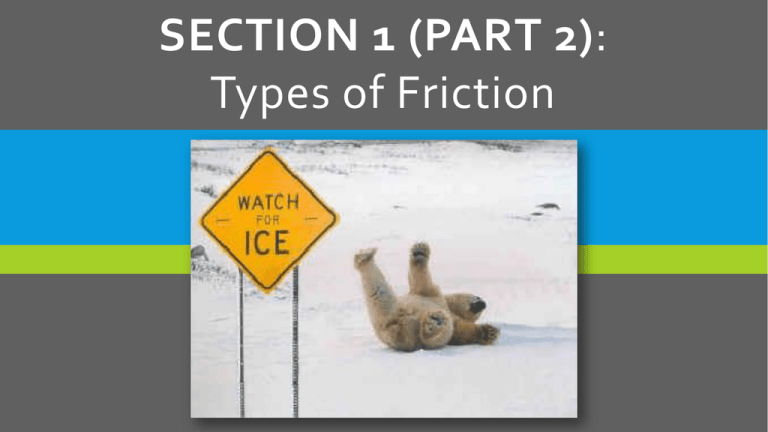Friction
advertisement

SECTION 1 (PART 2): Types of Friction WARM-UP: You push a skateboard on a flat surface. st According to Newton’s 1 Law of Motion what should happen? Does this happen? Why? LEARNING GOALS Describe the four different types of friction. Observe the effects of air resistance on falling objects. FRICTION Friction: a force that opposes motion between two surfaces that are touching each other. Why does this happen? FRICTION Microwelds form when microscopic dips and bumps that occur on a surface, no matter how smooth it may seem, come into contact with another surface. FRICTION The greater the force pushing the two surfaces together, the stronger the microwelds will be, which causes greater friction. For an object to move, the force must be strong enough to overcome the microwelds. TYPES OF FRICTION There are 4 main types of friction: Static Sliding Rolling Fluid STATIC FRICTION Occurs between two surfaces that are touching, but not moving past each other. The object will not move. SLIDING FRICTION Force that opposes the motion of two surfaces sliding past each other. ROLLING FRICTION Friction between the rolling object and the surface it rolls on FLUID FRICTION Occurs when a solid object is in contact with a fluid (a gas or liquid) and a force is applied to either the object or to the fluid Friction COEFFICIENT OF FRICTION Number which represents the friction between two surfaces Ranges from 0 -1 COEFFICIENT OF FRICTION The higher the coefficient, the greater the friction between the two surfaces SOLVING FOR THE COEFFICIENT OF FRICTION f= Fdrag Fgravity f = coefficient of friction (no units) Fdrag = the force it takes to drag the object in its normal direction of travel Fgravity = the weight of the same object in the same units as the drag force EXAMPLE A book has a weight of 5 N. It takes 3 N of force to drag the book across the surface of a sidewalk. What is the coefficient of friction?



